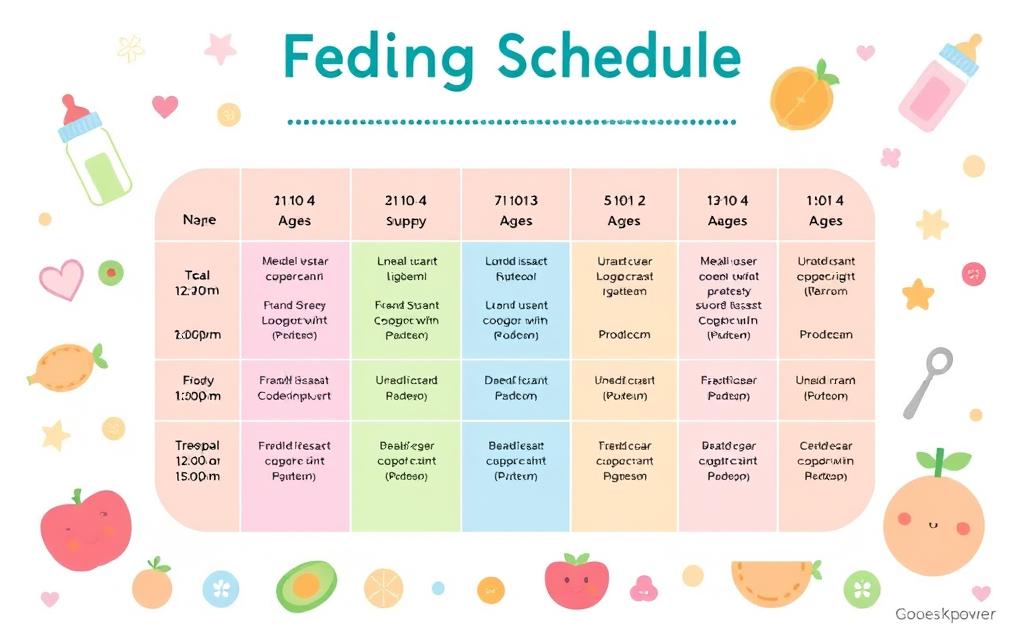Feeding Schedules for Infants: A Guide to Optimal Nutrition

A well-planned feeding schedule is key for an infant’s growth. It’s vital to understand the importance of good nutrition for a baby’s health. A feeding schedule ensures babies get the right nutrients at the right time, supporting their development.
Creating a feeding routine for infants can be tough. But with the right help, parents can set up a healthy schedule for their newborn. This schedule meets their baby’s needs.
It’s important to tailor a feeding schedule to each baby’s unique needs. A newborn’s schedule should be flexible, changing as the baby grows. By adjusting the schedule, parents can help their babies thrive and develop a good relationship with food.
Creating a feeding schedule helps babies develop healthy eating habits. It ensures they get the nutrients they need to grow. A good routine should consider the baby’s age, weight, and health.
A well-planned schedule helps parents overcome feeding challenges. It gives babies the best start in life.
Key Takeaways
- Establishing a feeding schedule for infants is critical for their growth and development
- A well-planned infant feeding routine should be flexible and adaptable to the changing needs of the baby
- A newborn feeding schedule should be based on the individual needs of the baby
- Parents should consider their baby’s age, weight, and overall health when creating a feeding schedule
- A feeding schedule for infants can help parents navigate the challenges of feeding their babies
- By following a well-planned infant feeding routine, parents can help their babies develop a healthy relationship with food
- A well-planned newborn feeding schedule can help ensure babies receive the nutrients they need to thrive
Understanding the Basics of Infant Feeding
Feeding your baby is a key part of their care. It’s important to know when they’re hungry. Signs include rooting, sucking on hands, or making sounds. A feeding chart for babies helps plan out feeding times and ensures they get the right nutrients.
Newborns need to eat often, usually every 2-3 hours. As they grow, their eating schedule will change. It’s vital to adjust to their needs.
There are different ways to feed a baby, like breastfeeding or formula. Each has its own benefits and challenges. Good nutrition is key for a baby’s growth. Knowing these basics helps you create a feeding schedule that meets your baby’s needs.
Recognizing Hunger Cues
- Rooting reflex
- Sucking on hands or objects
- Making feeding sounds
- Showing interest in the breast or bottle
Different Types of Feeding Methods
Breastfeeding and formula feeding are common choices. Think about your lifestyle and your baby’s needs when deciding.
The Importance of Proper Nutrition
A balanced diet is vital for a baby’s growth. The right nutrients support their health and well-being.
| Age | Feeding Frequency | Nutrient Needs |
|---|---|---|
| 0-3 months | Every 2-3 hours | Breast milk or formula, vitamins, and minerals |
| 4-6 months | Every 3-4 hours | Introduction to solid foods, continued breast milk or formula |
| 7-12 months | Every 4-5 hours | Solid foods, breast milk or formula, and introduction to cow’s milk |
Establishing a Feeding Schedule for Infants: Core Principles
Creating a infant feeding guidelines schedule is key for both the baby and parents. The best feeding schedule for infants must meet their changing nutritional needs. Newborns need to eat when they want, as it helps them grow and develop.
As the baby gets older, a more set schedule can be introduced. Watch for hunger signs like rooting or sucking on hands. This helps create a routine that suits everyone. Being flexible is also important, as babies’ appetites and growth can change.
Some important tips for a feeding schedule include:
- Feeding on demand for newborns
- Gradually introducing a more predictable schedule as the baby grows
- Being flexible to accommodate changes in appetite and growth spurts
- Paying attention to hunger cues, such as rooting or sucking on hands
By following these tips and knowing about infant feeding guidelines, parents can make a best feeding schedule for infants. This schedule will support their health and well-being.
Every baby is unique, and what works for one might not work for another. Being flexible and responsive to their needs helps create a schedule that supports their growth and development.
Newborn Feeding Patterns: Birth to Three Months
Newborns have small stomachs and need to eat often. They usually eat every 2-3 hours, day and night. As they grow, they eat less often. It’s important to watch for hunger signs and adjust their newborn feeding schedule as needed.
It’s key to understand how newborns eat to help them grow. Here are some important points:
- Feedings are usually every 2-3 hours, with 8-12 feedings in 24 hours.
- Nighttime feedings are essential, at least in the early weeks.
- Tracking feeding sessions can help parents identify patterns and make adjustments to the feeding schedule as needed.
By following a well-planned newborn feeding schedule and watching the feeding frequency for newborns, parents can help their baby get the nutrients they need. Remember, every baby is different. It’s important to be flexible and adjust the feeding schedule as needed to meet their individual needs.
Adapting Feeding Routines: Four to Six Months
As infants grow from four to six months, their infant feeding routine may need to change. This is because their nutritional needs change. Introducing solid foods can affect how often and how much milk they drink. It’s important to adjust the feeding routine to make sure they get the nutrients they need.
Parents should keep an eye on their baby’s baby feeding times and make changes as needed. Some things to consider include:
- Introducing solid foods can help supplement the baby’s diet and provide essential nutrients.
- Monitoring the baby’s weight and overall health can help determine if the current feeding routine is meeting their needs.
- Being flexible with the feeding schedule can help accommodate the baby’s changing needs and preferences.
A well-planned infant feeding routine is key for a baby’s growth and development. By paying attention to baby feeding times and making adjustments as needed, parents can help their baby thrive during this critical stage.

Remember, every baby is different. What works for one may not work for another. By staying attuned to their baby’s needs and making adjustments to the infant feeding routine as needed, parents can help their baby develop healthy eating habits and a strong foundation for future growth and development.
| Age | Feeding Frequency | Feeding Volume |
|---|---|---|
| 4-6 months | 4-6 times a day | 24-32 ounces |
Transitioning to Solid Foods: Six Months and Beyond
As babies grow, their food needs change. Around six months, they might show they’re ready for solid foods. They might sit up well, have good head control, and show interest in food. A feeding chart for babies helps parents keep track of their baby’s progress and know how often to feed newborn solids.
When starting solids, mix them with milk to ensure enough nutrients. A good meal plan includes fruits, veggies, proteins, and whole grains. Start with single-ingredient purees and add new foods slowly to watch for any allergy signs.
- Introducing new foods one at a time to monitor for allergies
- Offering a variety of foods to ensure a range of nutrients
- Continuing to provide milk feeds to support overall nutrition
By using a structured feeding chart for babies and knowing how often to feed newborn solids, parents can help their baby start eating solids. This supports their growth and development.
| Age | Food | Frequency |
|---|---|---|
| 6 months | Single-ingredient purees | 2-3 times a day |
| 7-8 months | Mashed fruits and vegetables | 3-4 times a day |
| 9-12 months | Soft, solid foods | 3-4 times a day |
Common Feeding Challenges and Solutions
Parents often face challenges when feeding their infants. Following guidelines and setting a good feeding schedule can help. But, it’s important to know how to handle common problems.
Feeding resistance, growth spurts, and schedule changes are common issues. Illness, teething, or being too full can cause resistance. Growth spurts make babies hungrier, needing a flexible schedule. Travel or illness can disrupt feeding times, making it key to meet nutritional needs.
To tackle these problems, parents can try these solutions:
- Be flexible with the feeding schedule to accommodate growth spurts
- Offer smaller, more frequent meals to help manage feeding resistance
- Keep a backup plan in place for disruptions to the feeding schedule, such as having a stash of expressed breastmilk or formula
Knowing these challenges and having a plan helps parents feed their babies well. Every baby is different, so what works for one might not work for another. Staying informed and adjusting to needs is essential for successful feeding.
| Feeding Challenge | Solution |
|---|---|
| Feeding Resistance | Offer smaller, more frequent meals |
| Growth Spurts | Be flexible with the feeding schedule |
| Disruptions to Feeding Schedule | Keep a backup plan in place, such as expressed breastmilk or formula |
Best Practices for Successful Infant Feeding
Creating a positive feeding experience is key for infants. A well-planned feeding schedule for infants helps establish a routine. It works for both the baby and the parents. It’s important to understand hunger cues and create a comfortable feeding space.
A successful infant feeding routine is about being patient and flexible. Every baby is unique, and what works for one might not work for another. Being adaptable and responsive to the baby’s needs helps create a nurturing feeding experience.
Some best practices for infant feeding include:
- Establishing a consistent feeding schedule to help the baby feel secure and develop a sense of routine
- Creating a comfortable and calm feeding environment to reduce stress and promote relaxation
- Responding to hunger cues to ensure the baby’s nutritional needs are met
- Being patient and flexible to accommodate the baby’s changing needs and preferences
By following these best practices and creating a well-planned feeding schedule for infants, parents can help their baby develop a healthy relationship with food. This supports their overall growth and development. An effective infant feeding routine is essential for nurturing the baby’s physical, emotional, and social well-being.
Creating a Sustainable Feeding Routine
Creating a consistent feeding routine is key for a baby’s growth. A well-planned feeding chart for babies helps parents stay organized. It ensures the baby gets the right nutrition at the right time. Consistency in baby feeding times helps manage their appetite and digestion.
To make a sustainable feeding routine, start with consistent mealtimes. Create a feeding chart for babies that shows feed frequency and duration. This routine helps your baby feel secure and develop a sense of predictability.
Establishing Consistent Mealtimes
- Create a feeding schedule that works for your baby’s unique needs
- Stick to the schedule as much as possible, even on weekends and holidays
- Be flexible and make adjustments as needed to accommodate changes in your baby’s routine
Adjusting Schedules for Different Situations
While consistency is key, being flexible is also important. Adjust baby feeding times for travel, changes in routine, or unexpected events. Being prepared helps keep your baby’s feeding routine effective and sustainable.
Conclusion: Nurturing Your Baby’s Growth Through Proper Feeding
As we wrap up this guide on feeding schedules for infants, it’s clear that feeding your baby right is key to good parenting. Knowing the basics of infant feeding helps parents give their babies the best nutrition for growth.
We’ve looked at different stages of feeding, from knowing when a newborn is hungry to starting solid foods. A consistent feeding schedule is important, but it should change as your baby grows. Every baby is different, so being flexible is essential for a good feeding routine.
Keep following your parenting path, listen to your gut, and watch your baby closely. Work with doctors to solve any feeding problems. With effort and patience, you can help your child develop good eating habits for life.






